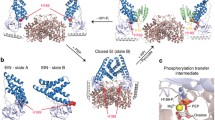Abstract
Siderocalin Q83 is a small soluble protein that has the ability to bind two different ligands (enterobactin and arachidonic acid) simultaneously in two distinct binding sites. Here we report that Q83 exhibits an intriguing dynamic behavior. In its free form, the protein undergoes significant micro-to-millisecond dynamics. When binding arachidonic acid, the motions of the arachidonic acid binding site are quenched while the dynamics at the enterobactin binding site increases. Reciprocally, enterobactin binding to Q83 quenches the motions at the enterobactin binding site and increases the slow dynamics at the arachidonic acid binding site. Additionally, in the enterobactin-bound state, the excited state of the arachidonic acid binding site resembles the arachidonic acid-bound state. These observations strongly suggest an allosteric regulation where binding of one ligand enhances the affinity of Q83 for the other one. Additionally, our data strengthen the emerging view of proteins as dynamic ensembles interconverting between different sub-states with distinct functionalities.




Similar content being viewed by others
Abbreviations
- NMR:
-
Nuclear magnetic resonance
- CPMG:
-
Carr Purcell Meiboom Gill
- AA:
-
Arachidonic acid
- DTT:
-
Dithiotreitol
References
Baldwin AJ, Kay LE (2009) NMR spectroscopy brings invisible protein states into focus. Nat Chem Biol 5(11):808–814
Bruschweiler S, Schanda P, Kloiber K, Brutscher B, Kontaxis G, Konrat R, Tollinger M (2009) Direct observation of the dynamic process underlying allosteric signal transmission. J Am Chem Soc 131(8):3063–3068
Cancedda FD, Malpeli M, Gentili C, Di Marzo V, Bet P, Carlevaro M, Cermelli S, Cancedda R (1996) The developmentally regulated avian Ch21 lipocalin is an extracellular fatty acid-binding protein. J Biol Chem 271(33):20163–20169
Carr HY, Purcell EM (1954) Effects of diffusion on free precession in nuclear magnetic resonance experiments. Phys Rev 94:630–638
Carver JP, Richards RE (1972) General 2-Site Solution for Chemical Exchange Produced Dependence of T2 Upon Carr-Purcell Pulse Separation. J Magn Reson 6:89
Coudevylle N, Geist L, Hotzinger M, Hartl M, Kontaxis G, Bister K, Konrat R (2010) The v-myc-induced Q83 lipocalin is a siderocalin. J Biol Chem 285(53):41646–41652
Delaglio F, Grzesiek S, Vuister GW, Zhu G, Pfeifer J, Bax A (1995) NMRPipe: a multidimensional spectral processing system based on UNIX pipes. J Biomol NMR 6(3):277–293
Karplus M, Kuriyan J (2005) Molecular dynamics and protein function. Proc Natl Acad Sci USA 102(19):6679–6685
Kay LE, Torchia DA, Bax A (1989) Backbone dynamics of proteins as studied by 15 N inverse detected heteronuclear NMR spectroscopy: application to staphylococcal nuclease. Biochemistry 28(23):8972–8979
Kern D, Zuiderweg ER (2003) The role of dynamics in allosteric regulation. Curr Opin Struct Biol 13(6):748–757
Lee AL, Kinnear SA, Wand AJ (2000) Redistribution and loss of side chain entropy upon formation of a calmodulin-peptide complex. Nat Struct Biol 7(1):72–77
MacRaild CA, Daranas AH, Bronowska A, Homans SW (2007) Global changes in local protein dynamics reduce the entropic cost of carbohydrate binding in the arabinose-binding protein. J Mol Biol 368(3):822–832
Meiboom S, Gill D (1958) Modified spin-echo method for measuring nuclear relaxation times. Rev Sci Instrum 29:688–691
Mittag T, Schaffhausen B, Gunther UL (2003) Direct observation of protein-ligand interaction kinetics. Biochemistry 42(38):11128–11136
Palmer AG III, Kroenke CD, Loria JP (2001) Nuclear magnetic resonance methods for quantifying microsecond-to-millisecond motions in biological macromolecules. Methods Enzymol 339:204–238
Tollinger M, Skrynnikov NR, Mulder FA, Forman-Kay JD, Kay LE (2001) Slow dynamics in folded and unfolded states of an SH3 domain. J Am Chem Soc 123(46):11341–11352
Tollinger M, Kloiber K, Agoston B, Dorigoni C, Lichtenecker R, Schmid W, Konrat R (2006) An isolated helix persists in a sparsely populated form of KIX under native conditions. Biochemistry 45(29):8885–8893
Wand AJ (2001) Dynamic activation of protein function: a view emerging from NMR spectroscopy. Nat Struct Biol 8(11):926–931
Acknowledgments
This work was supported by Austrian Science Fund (FWF) grants P20549-N19, P22125-B12, P17041, and P18148. NC is a recipient of a Lise Meitner FWF Fellowship. We are deeply grateful to Lewis Kay for the ingenious development and the generous distribution to the community of his pulse sequences.
Author information
Authors and Affiliations
Corresponding authors
Rights and permissions
About this article
Cite this article
Coudevylle, N., Geist, L., Hoetzinger, M. et al. Siderocalin Q83 exhibits differential slow dynamics upon ligand binding. J Biomol NMR 51, 83 (2011). https://doi.org/10.1007/s10858-011-9543-z
Received:
Accepted:
Published:
DOI: https://doi.org/10.1007/s10858-011-9543-z




